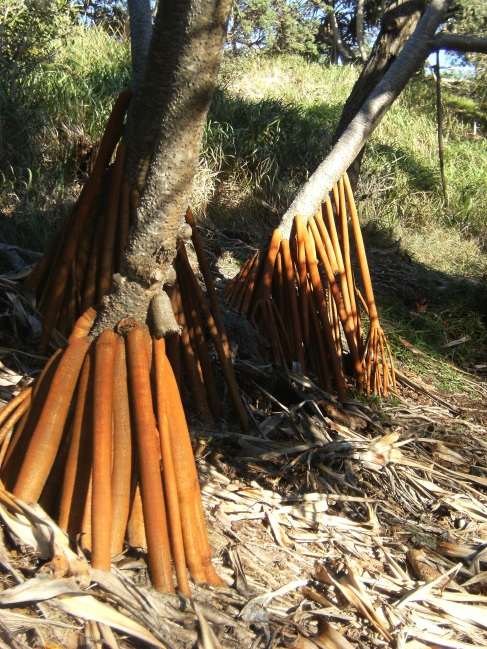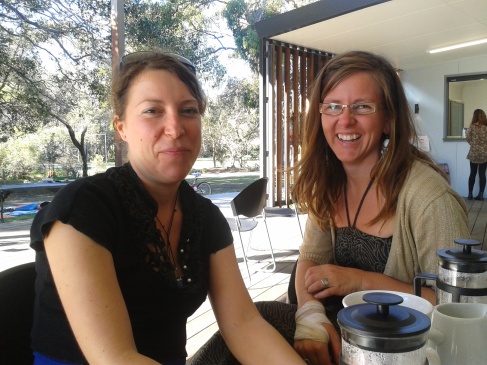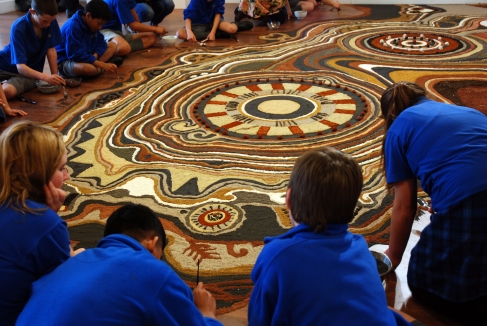So we’re here at Point Lookout Hall, surrounded by weavers and printers and everyone is making something and chatting and playing. I’m talking with Ekerasa and Karma, who work together as a team (and also maintain their own art practices). As a team, they call themselves Imagine the Land and they work as installation/land art practitioners.
Ekerasa, who is Croatian by birth, says, “You know, people have this idea about land art being very big and overpowering, but we actually work with soil and minerals, often on the land itself, but always speaking somehow about connection to place.” (Below is a 2012 project done at The Wallace Gallery, Auckland with 500 school age children.)
(Above, What Lies Beneath, 2013, Lopdell House, Auckland)
“Our practice occurs in two parts,” explains Karma, “We work as artists in collaboration – that’s one side of the work – and then there is the participatory side, when people work with us – these aspects feed into each other, but our collaborative work together is much more refined. There is the process-driven part of the work that again feeds back into the participatory.”
Ekerasa says, “It gives the audience a different relationship to the art world when they see the artist making the work, rather than a piece hung on the wall. This is great, too, but in most gallery settings you don’t usually see the artist at all. It makes it more relational, instead of there being a disconnection for the viewer from the artist.”
“People get really excited. They come to see the work more than once and bring family and friends, especially when there is a construction element. People really relate to the live construction and they build a relationship with the work as well as with us,” says Karma.
And it’s interesting for me to see how these two women think together and work off of each other’s wonderful energy. They like to build layers of relationships – “relational” is a word they use often in their conversation. So, they create the first ‘relation’ by going out into the landscape and finding the materials they will use in their work, and finding out about those materials and how they function within their ‘home’ ground.
Then, “if people have been to one of the places where our materials have come from,” explains Karma, “it generates this kind of land and place connection. Just for people to see the earth colours in a new place and context, highlights for them all the possibilities of new ways to look at nature and everything around them.”
Karma goes on to say, “Our outdoor works are very grunty, but our indoor materials are more refined – more like pigments – finer and softer, and we work with tools and brushes to apply them. Outside we apply directly with our hands, sometimes with spoons for the little kids.”
And they say that as far as being at LINES – “It’s been very good for us to have this time for reflection – to work on both our thinking and processes. We live in different countries (Ekerasa lives in New Zealand and Karma lives in New South Wales) and for us to have a week together at LINES in a place like Straddie, is an amazing opportunity to really be in synch with each other, to explore our practice and to network with other artists of likeminded sensibility,” they say.
“The first two days here, we were looking at nature and taking photos and noticing interesting sites for installations along the Gorge Walk. In the evening we would look at the photos we’d taken and discuss the different sites and their pros and cons. We also went around the island to look at materials we could use, mostly along the sides of the roads – edges of environments. Already disturbed environments are where we like to deploy materials, not intervening in local ecologies. We are very sensitive to how we interact with the environment, of course, and a roadside is a meeting place for natural habitat and manmade activity. Roadcuts have less life. We take from the surface when we gather minerals and sand and we don’t take too much from one place.”
Ekerasa explains that, “You actually start looking at the environment with different eyes by default. Now I see all these different colours and patterns, and it grows an interesting sensitivity because now they have possibilities as materials. Once you start working with them, you realize these worlds of possibilities. At this point, we are just scratching the surface. We’ve been treating them as colours and as a colour palette, but there are much more significant and deeper connotations to be found in the meaning behind the materials and the way they belong to a place. Here on Stradbroke, while we were driving around, we noticed very clean, white sand (silica which is actually mined by the mining company) and black sand which we later learned is also extracted from the island by the mining company. Craig Tapp gave us three types of sand: light yellow, orange and black and of course these have meanings for the Quandamooka people. Tappy was very generous with sharing materials with us visiting artists.”
“We just want to say that we have been really blessed with being here. This is a beautiful festival,” says Ekerasa. “We were able to work with over sixty people during the participatory phase of our project,” says Karma. “Not only did we meet and work with these people, but what stood out from it all was those peoples’ experience, and how they were able to spend family and nature time together. We allowed them a platform to have that time and to expand into expressing themselves through local materials within a very special art environment.”
Ekerasa summed it up: “We worked within a completely new environment. Pushing our practice here has been an experiment that has really shown us new pathways for future work.”






